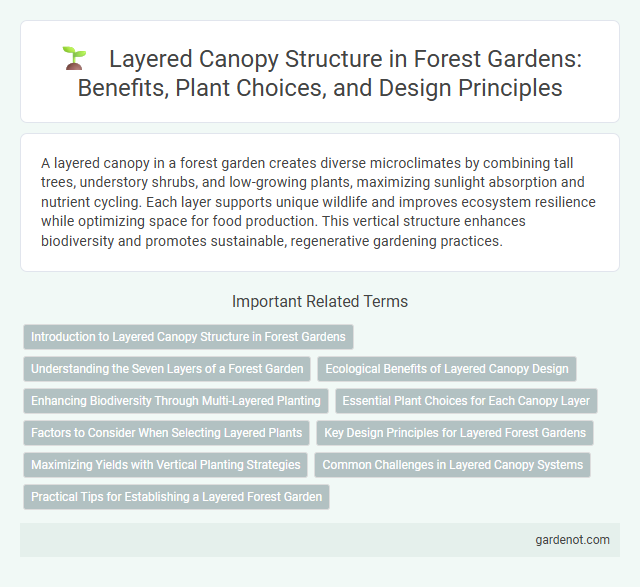A layered canopy in a forest garden creates diverse microclimates by combining tall trees, understory shrubs, and low-growing plants, maximizing sunlight absorption and nutrient cycling. Each layer supports unique wildlife and improves ecosystem resilience while optimizing space for food production. This vertical structure enhances biodiversity and promotes sustainable, regenerative gardening practices.
Introduction to Layered Canopy Structure in Forest Gardens
A layered canopy structure in forest gardens mimics natural forest ecosystems by organizing plants in vertical strata ranging from tall emergent trees to low groundcovers. This arrangement enhances biodiversity, optimizes sunlight capture, and improves nutrient cycling within the garden. Incorporating layered canopies promotes habitat variety and increases overall productivity and resilience of the forest garden system.
Understanding the Seven Layers of a Forest Garden
A forest garden's layered canopy consists of seven distinct strata: the towering emergent layer, the tall tree layer, the low tree layer, the shrub layer, the herbaceous layer, the ground cover layer, and the root layer. Each layer serves a unique ecological function, from capturing sunlight at the emergent and tall tree layers to providing soil fertility through root systems and ground cover vegetation. Understanding these layers optimizes sustainable plant diversity, maximizes space utilization, and supports biodiversity within the forest garden ecosystem.
Ecological Benefits of Layered Canopy Design
A layered canopy design in forest gardens mimics natural forest structures, enhancing biodiversity by providing diverse habitats for flora and fauna. This stratification improves microclimate regulation, promoting soil moisture retention and reducing temperature extremes. Increased photosynthetic efficiency from multiple vegetation layers boosts carbon sequestration, contributing to climate change mitigation.
Enhancing Biodiversity Through Multi-Layered Planting
A layered canopy in a forest garden creates diverse habitats by incorporating trees, shrubs, herbs, and ground cover plants stacked vertically. This multi-layered planting strategy enhances biodiversity by supporting various wildlife species, improving soil health, and fostering resilient ecosystems. Integrating nitrogen-fixing plants and pollinator-friendly species further enriches the nutrient cycle and promotes ecological balance.
Essential Plant Choices for Each Canopy Layer
The layered canopy of a forest garden includes distinct plant choices for each layer: towering fruit and nut trees dominate the emergent layer, while mid-story shrubs like elderberry and hazelnut provide essential yield and habitat. Underneath, dwarf fruit trees and berry bushes such as currants and gooseberries thrive, optimizing light capture and space. Ground cover plants like strawberries and medicinal herbs efficiently suppress weeds and enhance soil health, creating a balanced, productive ecosystem.
Factors to Consider When Selecting Layered Plants
Selecting plants for a layered canopy in a forest garden requires careful consideration of sunlight availability, ensuring that taller species do not excessively shade lower layers to maintain photosynthesis efficiency. Soil type and moisture levels must be matched with each plant's specific requirements to promote healthy growth and resource sharing within the ecosystem. Plant compatibility, including root depth variation and nutrient needs, supports biodiversity and reduces competition, fostering a resilient and productive forest garden structure.
Key Design Principles for Layered Forest Gardens
Layered canopy in forest gardens maximizes space by incorporating multiple vegetation strata such as tall trees, understory trees, shrubs, herbs, and ground cover. Key design principles emphasize selecting species with complementary growth habits and light requirements to optimize sunlight capture and nutrient cycling. Integrating nitrogen-fixing plants and dynamic accumulators enhances soil fertility while maintaining biodiversity across vertical layers.
Maximizing Yields with Vertical Planting Strategies
Layered canopy design in forest gardens maximizes yields by utilizing vertical planting strategies that mimic natural forest structures. This approach integrates tall trees, understory shrubs, and ground-level herbs to efficiently capture sunlight and space, enhancing overall productivity. Incorporating multiple layers increases biodiversity and resource use efficiency, promoting sustainable food production.
Common Challenges in Layered Canopy Systems
Layered canopy systems in forest gardens often face challenges such as uneven light distribution, which can hinder the growth of understory plants and reduce overall biodiversity. Managing competition for nutrients and water between multiple canopy layers requires precise soil health monitoring and targeted fertilization strategies. Pest and disease management becomes complex due to the dense vegetation, necessitating integrated pest management approaches tailored to multi-layered ecosystems.
Practical Tips for Establishing a Layered Forest Garden
Establishing a layered canopy in a forest garden involves selecting diverse plant species with varying heights, from tall trees to low-growing ground covers, to maximize space and resource use. Prioritize native or well-adapted plants that provide multiple functions such as food, nitrogen fixation, and habitat support, ensuring ecological balance and resilience. Implement strategic spacing and succession planting to encourage natural shade gradients and optimize light penetration for understorey crops.
Layered canopy Infographic

 gardenot.com
gardenot.com